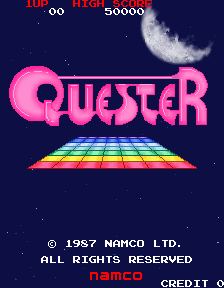Quester (Japan)
Screenshots










Download Details
| split set | quester.zip 156.35k |
| merged set | quester.7z 131.80k |
| standalone set | quester.7z 125.65k |
Game Details
Arcade Video game published 38 years ago:
Quester (c) 1987 Namco ltd.
The player must move a paddle left and right across the bottom of the screen deflecting a ball to hit bricks. Some bricks contain special power-ups to enhance play.
- TECHNICAL -
Namco System 1 hardware
Game ID: QS
Screen orientation: Vertical
Video resolution: 224 x 288 pixels
Screen refresh: 60.61 Hz
Palette colors: 24-bit RGB palette
Players: up to 2 (alternate)
Control: Dial
Buttons: 1
[A] = shoot the ball
- TRIVIA -
Quester was released in September 1987 in Japan only. It represented at its time the Namco's response to Taito's "Arkanoid".
Round #2 is inspired by round #3 of Arkanoid, although the red blocks can be destroyed after a few shots. Round #5 shows a flagship from Galaxian. Round #6 shows Pac-Man.
Completion of the game gives you the image of Earth, eastern hemisphere with western side of the Pacific ocean and then appears the CGI sequence with the capsule landing in the aeronautical base during daytime.
Creative staff is written in white, engineering - in yellow (programming section) and red (hardware section).
Even if you complete entire game, you'll still a game over.
The high score allows you to put 8 characters.
Victor Entertainment released a limited-edition soundtrack album for this game (Namco Video Game Graffiti Vol.4 - VDR-5282) on 08/03/1989.
- TIPS AND TRICKS -
* Quester is a timed game. Complete the stage in less than 2 minutes to get bonus. The time you required to complete the stage is shown after it. Otherwise, you'll see time 'UP' in the post-stage box and you'll get no bonus.
* There are 2 types of blocks speeding the ball up or slowing it down: the red triangle pointed up speeds the ball up, blue triangle pointed down - slows it down. You may need to avoid both blocks.
* Pick the 'B' power-up and as soon as the molecule appears, insert the ball there to increase the ball count rapidly. This tip is useful for stage #4.
* Watch out for meteorites: they shorten the paddle.
* Take 'L' power-up to mount a barrier.
* Bonus stages occur every 7 rounds. They require you to push the fire button to shoot the balls and clear all the blocks in 15 seconds.
* A bunch of stages feature disco blocks - they add red ones next to flashing bricks. Shoot them 4 times to wipe them out of the play-field.
* Complete 33 stages.
- STAFF -
[CREATIVE] Game designer: Shinji Noguchi
[CREATIVE] Field designers: Toru Iwatani, Shinji Noguchi, Yukihiko Yagi
[CREATIVE] Graphic designers: Nobutaka Nakajima, Shinji Noguchi, Yukari Miyagi, Satoshi Norimatsu, Michiyo Yamashita
[CREATIVE] Title logo designer: Akira Usukura
[CREATIVE] Music composer: Shinji Hosoe
[ENGINEERING, PROGRAMMING SECTION] Game sequence: Kosei Matsuura
[ENGINEERING, PROGRAMMING SECTION] Device driver: Atsushi Yuhara
[ENGINEERING, PROGRAMMING SECTION] Sound driver: Junko Ozawa, Takatoshi Kobayashi
[ENGINEERING, PROGRAMMING SECTION] Hardware test: Hideto Yamazaki
[ENGINEERING, HARDWARE SECTION] PCB & chip design: Toru Ogawa, Makoto Inoue, Tsutomu Fujita, Takao Okada, Kazukiyo Shinozaki
[ENGINEERING, HARDWARE SECTION] Control panel: Akira Ohsugi, Hiroyuki Kobayashi
[PROBABLY CREATIVE] Produced by: Toru Iwatani
- CONTRIBUTE -
Edit this entry: https://www.arcade-history.com/?&page=detail&id=2104&o=2
Quester (c) 1987 Namco ltd.
The player must move a paddle left and right across the bottom of the screen deflecting a ball to hit bricks. Some bricks contain special power-ups to enhance play.
- TECHNICAL -
Namco System 1 hardware
Game ID: QS
Screen orientation: Vertical
Video resolution: 224 x 288 pixels
Screen refresh: 60.61 Hz
Palette colors: 24-bit RGB palette
Players: up to 2 (alternate)
Control: Dial
Buttons: 1
[A] = shoot the ball
- TRIVIA -
Quester was released in September 1987 in Japan only. It represented at its time the Namco's response to Taito's "Arkanoid".
Round #2 is inspired by round #3 of Arkanoid, although the red blocks can be destroyed after a few shots. Round #5 shows a flagship from Galaxian. Round #6 shows Pac-Man.
Completion of the game gives you the image of Earth, eastern hemisphere with western side of the Pacific ocean and then appears the CGI sequence with the capsule landing in the aeronautical base during daytime.
Creative staff is written in white, engineering - in yellow (programming section) and red (hardware section).
Even if you complete entire game, you'll still a game over.
The high score allows you to put 8 characters.
Victor Entertainment released a limited-edition soundtrack album for this game (Namco Video Game Graffiti Vol.4 - VDR-5282) on 08/03/1989.
- TIPS AND TRICKS -
* Quester is a timed game. Complete the stage in less than 2 minutes to get bonus. The time you required to complete the stage is shown after it. Otherwise, you'll see time 'UP' in the post-stage box and you'll get no bonus.
* There are 2 types of blocks speeding the ball up or slowing it down: the red triangle pointed up speeds the ball up, blue triangle pointed down - slows it down. You may need to avoid both blocks.
* Pick the 'B' power-up and as soon as the molecule appears, insert the ball there to increase the ball count rapidly. This tip is useful for stage #4.
* Watch out for meteorites: they shorten the paddle.
* Take 'L' power-up to mount a barrier.
* Bonus stages occur every 7 rounds. They require you to push the fire button to shoot the balls and clear all the blocks in 15 seconds.
* A bunch of stages feature disco blocks - they add red ones next to flashing bricks. Shoot them 4 times to wipe them out of the play-field.
* Complete 33 stages.
- STAFF -
[CREATIVE] Game designer: Shinji Noguchi
[CREATIVE] Field designers: Toru Iwatani, Shinji Noguchi, Yukihiko Yagi
[CREATIVE] Graphic designers: Nobutaka Nakajima, Shinji Noguchi, Yukari Miyagi, Satoshi Norimatsu, Michiyo Yamashita
[CREATIVE] Title logo designer: Akira Usukura
[CREATIVE] Music composer: Shinji Hosoe
[ENGINEERING, PROGRAMMING SECTION] Game sequence: Kosei Matsuura
[ENGINEERING, PROGRAMMING SECTION] Device driver: Atsushi Yuhara
[ENGINEERING, PROGRAMMING SECTION] Sound driver: Junko Ozawa, Takatoshi Kobayashi
[ENGINEERING, PROGRAMMING SECTION] Hardware test: Hideto Yamazaki
[ENGINEERING, HARDWARE SECTION] PCB & chip design: Toru Ogawa, Makoto Inoue, Tsutomu Fujita, Takao Okada, Kazukiyo Shinozaki
[ENGINEERING, HARDWARE SECTION] Control panel: Akira Ohsugi, Hiroyuki Kobayashi
[PROBABLY CREATIVE] Produced by: Toru Iwatani
- CONTRIBUTE -
Edit this entry: https://www.arcade-history.com/?&page=detail&id=2104&o=2
Driver Details
| source | namco/namcos1.cpp |
| status | good |
| emulation | good |
| savestate | supported |
Screen Details
| display | screen |
| type | raster |
| orientation | horizontal |
| width | 288px |
| height | 224px |
| refresh | 60.61mhz |
Input Details
| player | 1 |
| type | dial |
| buttons | 1 |
| directions | N/A |
| player | 2 |
| type | dial |
| buttons | 1 |
| directions | N/A |
Chipset Details
| name | Motorola MC6809E |
| clock | 1.46mhz |
| name | Motorola MC6809E |
| clock | 1.46mhz |
| name | Motorola MC6809E |
| clock | 1.46mhz |
| name | Hitachi HD63701V0 |
| clock | 5.86mhz |
| name | Speaker |
| clock | N/A |
| name | YM2151 OPM |
| clock | 3.41mhz |
| name | Namco CUS30 |
| clock | 11.72khz |
| name | 8-Bit R-2R DAC |
| clock | N/A |
| name | 8-Bit R-2R DAC |
| clock | N/A |
ROM Details
| name | size | crc |
|---|---|---|
| qs1_s0.bin | 64.00k | c2ef3af9 |
| qs1_p5.bin | 64.00k | c8e11f30 |
| qs1_p7b.bin | 64.00k | f358a944 |
| cus64-64a1.mcu | 4.00k | ffb5c0bd |
| qs1_v0.bin | 64.00k | 6a2f3038 |
| qs1_c8.bin | 64.00k | 06730d54 |
| qs1_c0.bin | 128.00k | ca69bd7a |
| qs1_c1.bin | 128.00k | d660ba71 |
| qs1_c2.bin | 128.00k | 4686f656 |
| qs1_o0.bin | 64.00k | e24f0bf1 |
| qs1_o1.bin | 64.00k | e4aab0ca |